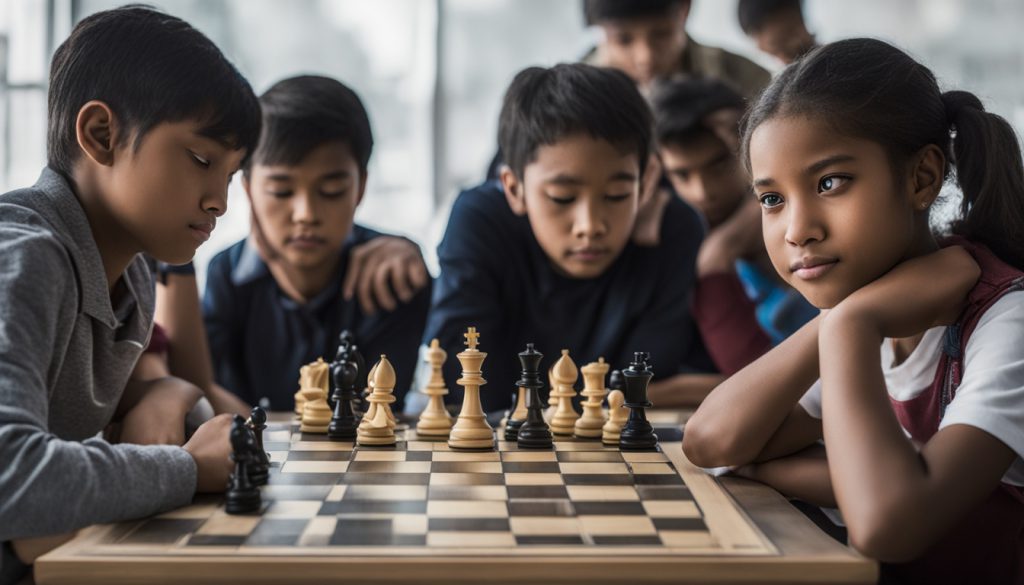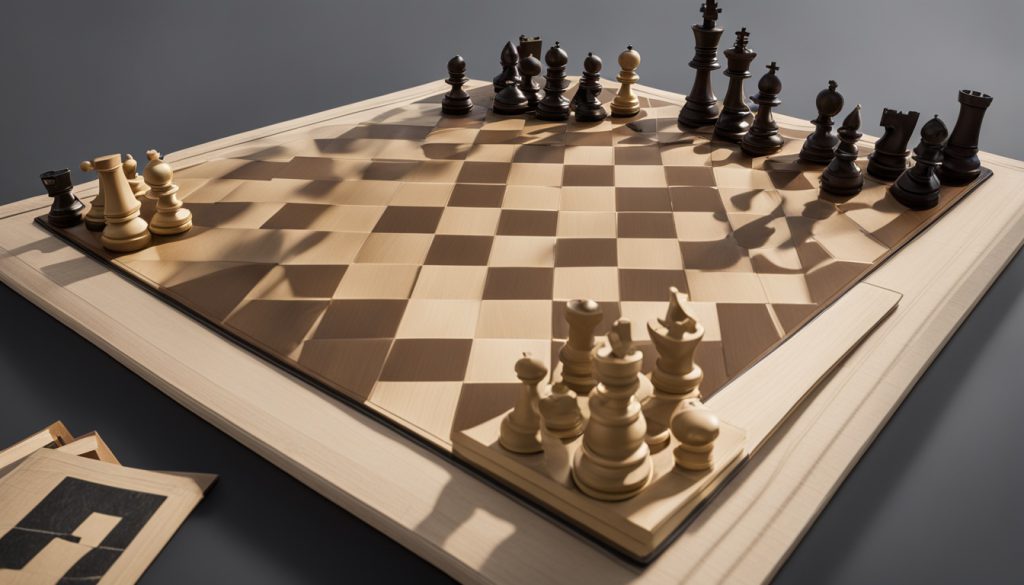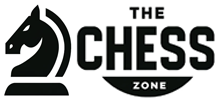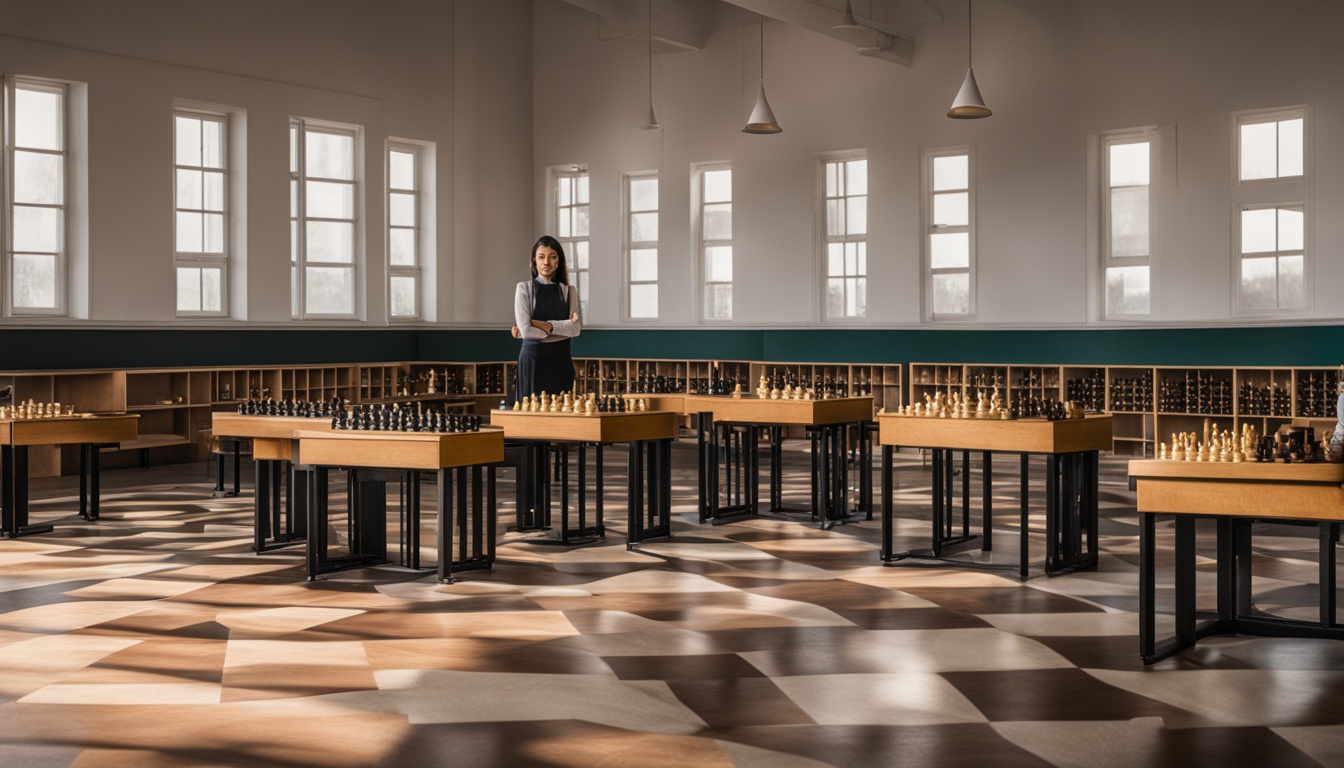Picture a room full of eager students, all focused on their chessboards. As a teacher, watching them apply critical thinking is truly rewarding. The first time I introduced chess in class, it changed everything. It taught them patience, strategy, and how to keep going.
Chess House believes in the power of chess as an educational tool. Founded in 1972, it has helped over 265,000 individuals. With 21,522 five-star reviews, Chess House is a trusted name for educational chess sets.
Key Takeaways
- Chess improves critical thinking and problem-solving in students.
- Chess House, established in 1972, is a reputable source for educational resources.
- Chess turns the classroom into a dynamic place of learning.
- Over 265,000 people have enjoyed Chess House’s quality chess sets.
- 21,522 customers have given Chess House five stars.
Introduction to Chess in the Classroom
Chess has been loved for centuries for its deep strategy and ability to hook both kids and adults. In the United States, schools are increasingly adding chess to their lessons. This trend is boosting curriculum development with exciting, smart content.
Blending chess into learning is key for matching it with common teaching methods. It encourages critical thinking, focus, and grit in students. Kids playing chess see big boosts in brainpower, helping them in other school subjects too.
For teachers, it’s vital to make chess lessons fun and welcoming. This involves smart curriculum development and mixing old and new teaching ways. Tech, like interactive chess apps, has changed how people learn chess. These apps offer detailed guides, engaging lessons, and challenges for all levels. They also use AI to give feedback and adjust to each player’s skills.
Chess also builds a community feel among kids. Online chess tools let them play with others, near and far. The class meets twice a week from August 13 to August 23, then weekly after August 27. Students will learn the basics, like chess language, study game plays, and discover clever tactics. Noted teachers Yule Park and Rishi Murali will lead them. The journey ends with a tournament on September 17 to see how much they’ve learned.
Benefits of Teaching Chess to Students
Chess offers unique benefits in classrooms, enhancing both thinking and emotional growth. We’ll see how chess improves critical thinking, problem-solving, and keeps students engaged.
Enhancing Critical Thinking Skills
Critical thinking is vital in education today, and chess helps develop this skill. Research shows chess players gain in cognitive abilities. For example, a Pennsylvania study from 1979-1983 revealed that chess players did better on tests of critical thinking and creativity.
In Belgium, from 1974-1976, fifth graders playing chess showed better cognitive growth. They scored higher on school tests and standardized exams.
Improving Problem-Solving Abilities
Chess also boosts problem-solving skills. It makes students think ahead and explore different outcomes. A study in Hong Kong from 1977-1979 found chess players improved in math and science by 15%.
Research in New Brunswick from 1989-1992 showed better math problem-solving and understanding. These studies show chess in schools helps students think analytically.
| Study Period | Location | Improvement Area | Results |
|---|---|---|---|
| 1973-74 | Zaire | Numerical, Spatial, Verbal | Significant advancements |
| 1974-76 | Belgium | Cognitive Development | Significant gains in standardized tests |
| 1977-79 | Hong Kong | Math and Science | 15% improvement in test scores |
| 1989-92 | New Brunswick, Canada | Math Problem-Solving | Increased comprehension |

Boosting Student Engagement
Chess quickly boosts students’ involvement in school. The game grabs their attention and motivates them. A Venezuela study from 1979-1983 saw IQ growth in kids from all backgrounds due to chess.
In 1985, a Kishinev study found chess players had better memory and imagination. This led to better grades. The St. Louis Chess Club research showed that 72% of students felt more confident, while 75% were more motivated to face challenges.
This excitement and focus on learning improve both grades and students’ outlook on education.
“Chess is not just a game; it’s a learning tool that has consistently proven to develop critical thinking and problem-solving skills, thus enhancing overall student engagement.”
Getting Started with Classroom Chess
Chess can really change the game in the classroom. It boosts critical thinking and problem-solving skills. To start, pick the right tools and create a space that encourages chess learning.
Choosing the Right Chess Sets and Boards
Choosing good chess sets and boards is key for learning. I suggest sets that are affordable and have large print. It helps students see the board clearly. Chess House has a great selection for schools.
Also, think about getting chess boards with fun themes. They catch students’ interest. This makes chess more fun and easier for kids to get into.
Creating a Chess-Friendly Environment
Make the classroom welcoming for chess. Have a special area set up for it. Set up chairs and tables so everyone can see and learn from each other’s moves. This encourages teamwork.
Use big demonstration boards to help students see the moves better. Adding interactive chess software adds a modern touch. This software comes with AI that gives feedback. It helps students see what they’re doing well and where they can improve.
Tips for Teaching Chess in the Classroom
With the right tools and a well-set-up classroom, you can make a chess-friendly environment. This will get students excited and build their strategic thinking skills.
Effective Teaching Techniques for Chess
Teaching chess in the classroom means using fun and interactive methods. Let’s look at some ways to make chess lessons more exciting. This can really help students get into chess.
Interactive Learning Methods
One top way to teach chess is by making lessons interactive. Using big demonstration boards helps a lot. They make it easy to see moves and strategies. Also, chess software with AI and social features makes learning fun. These tools boost interest and help students feel part of the chess world.
Hands-on demos let students dive into chess by playing and planning strategies. By using online tutorials and books, we offer deep dives into chess topics. It’s key to start with the basics, like the roles of the different pieces. This gives students a strong chess foundation.
Incorporating Chess into Standard Curriculum
Chess also fits well with regular school subjects. “Teaching Chess in the 21st Century” shows how to combine chess with math. This approach boosts students’ problem-solving and logical thinking.
Setting up chess practices through tournaments and chess clubs is vital. It lets students put what they learn into action. Playing against others, whether online or in person, offers valuable feedback. This helps them grow.
A supportive learning space is crucial. It’s important to see mistakes as learning chances. Kind feedback can really help boost confidence. These strategies encourage students to see chess as both fun and educational.
Top Educational Resources for Chess
Empowering students through chess requires access to high-quality educational resources and educational tools. Books, workbooks, or online platforms are all available to support learners at all levels. Here’s a guide to the top resources available.
Books for Beginners
Beginner’s books are perfect for sparking a student’s interest in chess. Notable mentions include “Chess for Students” and Bardwick’s educational chess books series. They provide foundational knowledge in an exciting, easy-to-understand way.
Workbooks and Practice Materials
Mastering chess comes with practice. Bardwick’s series offers comprehensive workbooks with exercises to refine students’ skills. These educational tools help transition from theory to practice efficiently.
Online Platforms and Tools
In today’s digital world, online resources are key for chess fans. Classes on Udemy are highly favored, thanks to high enrollments and success stories. Standout courses include:
| Course | Provider | Enrollments | Workload |
|---|---|---|---|
| Intro To Chess Crash Course | Chess University on Udemy | 20K | – |
| Best Chess Course to Master Tactics and Combinations | Udemy | 8.8K | 21 hours |
| Understanding Chess Openings | Mykhaylo Oleksiyenko on Udemy | 5K | – |
| The Complete Guide to Chess Tactics | Tryfon Gavriel on Udemy | 8.8K | – |
| Kids Learn Chess the Fun & Easy Way! | Mike Klein on Udemy | 32K | – |

These courses have attracted over 65.8K enrollments on Class Central, showing how effective and popular they are. Plus, the “Best Chess Masterclass with Garry Kasparov” on MasterClass offers tips from a chess legend. This highlights the platform’s role as an educational tool.
With so many educational resources out there, educators can easily find the right tools to inspire and teach students about chess.
Classroom Guide: Tips for Managing Chess Lessons
Effective chess class management blends classroom management tips with lesson planning ideas. I’ve gathered key strategies from research and experience. These ensure your chess lessons are both smooth and engaging.
Start by using large demonstration boards. They greatly enhance students’ visualization and engagement. Visual aids keep students focused and help them grasp complex chess positions better.
Introducing interactive chess software is also key. It makes lessons dynamic and lets students practice and compete online. With features for virtual tournaments, it builds community among learners.
GM Fabiano Caruana recently shared insights on effective classroom management and interactive learning. His advice from a group lesson, including tips on studying openings and improving visualization, was highly beneficial for teachers and students alike.
Maintaining a positive learning environment is essential. It’s important to foster respect and encouragement. By promoting teamwork and mutual learning, the classroom becomes a safe space for exploring and growing.
- Incorporate a variety of activities in your lessons, like lectures, practicals, and interactive exercises. This approach engages different kinds of learners.
- Keep your lessons paced consistently yet stay open to adjustments. Adapt based on how well students are picking up the material.
- Participate in professional development and chess teaching workshops. These can refine your teaching skills with new strategies and ideas.
| Strategy | Description | Benefits |
|---|---|---|
| Large Demonstration Boards | Improves visualization and student engagement. | Enhanced understanding and retention of chess concepts. |
| Interactive Chess Software | Dynamic and engaging learning and practice tools. | Increased motivation and skill improvement through online competitions. |
| Positive Learning Environment | Fostering respect and encouragement among students. | Safe space for learning and personal growth. |
Using these classroom management tips and lesson planning ideas, you’ll craft rewarding chess lessons. Remember, guiding students on their unique paths with patience and support is key to their success.
Student Engagement Strategies for Chess
Getting students involved in chess is rewarding for teachers and students alike. By using effective student engagement strategies, chess lessons become exciting and educational.
Using Stories and Examples
Stories and real-world examples are great for sparking interest in chess. Elliott Neff, from Chess4Life, excels in this approach. He plays multiple people at once, sometimes blindfolded, and shares interesting stories from his chess journey. These stories can motivate students and highlight the game’s strategic aspects.
Tips from players like Grandmaster Varuzhan Akobian and others make chess more relatable and fun. Chess4Life’s “6 Key Chess Club Guide” is another excellent tool. It’s free and well-liked. Using it can help your students boost their chess abilities in an organized way.
Encouraging Peer Learning
Peer learning is a key student engagement strategy for chess classrooms. When students work together on puzzles and games, they learn more about chess. It also helps create a teamwork-based learning environment.
Building a classroom culture that values peer learning is crucial. Discussing games and strategies in groups can deepen students’ understanding. It makes chess a shared activity. This approach also reinforces their knowledge and keeps them engaged.
Chess House offers many chess resources. They’ve helped over 265,000 people find the right chess set and have a 5-star rating from 21,522 customers. Using their materials in your classroom guide can make learning more effective.
For the latest in keeping students interested, check out Chess House’s educational blog. It offers useful tips for the modern classroom.
Lesson Planning Ideas for Chess
Introducing chess to the classroom is both exciting and enriching for students and teachers. To make the most of it, it’s crucial to plan your lessons well. I’ll share useful tips on organizing chess education. Resources like Bardwick’s books and ChessKid’s Classroom Planner help cater to all skill levels.
Structuring Your Lesson Plan
A good lesson plan is key to teaching chess effectively. The ChessKid Classroom Planner, by WFM Elizabeth Spiegel, guides you week by week. It’s made for kindergarten to fifth grade, fitting perfectly into modern teaching methods.
Begin with clear goals for each class. For example:
- Week 1: Introduction to the chessboard and pieces
- Week 2: Basic moves and capturing
- Week 3: Check and checkmate scenarios
Keep students interested with interactive activities and visuals. “Chess in the Classroom: A Teacher’s Guide” provides a 30-week plan for a structured learning experience.
Incorporating Different Skill Levels
Teaching chess to students of various skills can be tough. Here are some ideas:
- Beginners: Start with simple exercises on basic rules. ChessKid’s Classroom Planner has great content for beginners.
- Intermediate: Teach strategy and opening moves. Have students solve puzzles and play games to improve.
- Advanced: Offer challenging endgames and tactics. Let them lead sessions to learn together.
With these tips and a focus on organizing your classroom, you can create an engaging chess curriculum. Adapting your lessons for different abilities allows every student to progress at their own pace.
Implementing Chess Tournaments in School
Hosting chess tournaments in schools is a great idea. It can increase student involvement, build community, and teach key life lessons. Teachers need good classroom management tips and strategies to run these tournaments well.
Organizing School-Wide Tournaments
Planning is crucial for school-wide chess tournaments. Make sure there’s a clear plan and schedule for everyone. Then, get the supplies you need like chessboards, pieces, and clocks. Schools might work with Chess House for top-notch supplies. You can also use online tools to handle sign-ups and keep track of scores easily.
Encouraging Participation and Fair Play
Get the word out through school newsletters and announcements. Ask every student to participate, no matter their chess level. Stress that the aim is to enjoy and learn. Giving out certificates or small rewards can motivate them. Plus, make sure to have clear rules for a fair and inclusive tournament.
“Chess tournaments can build a sense of teamwork and community in schools, making it a wonderful addition to the educational curriculum.”
To make chess tournaments a hit, using the right student engagement strategies is important. Use these tips to build a welcoming and energized chess atmosphere at school.
Here’s a handy guide for setting up a school chess tournament:
- Plan the tournament structure and schedule
- Gather necessary supplies and resources
- Promote the event and encourage participation
- Establish rules for fair play and inclusivity
- Manage registrations and track results
Using this guide will help ensure a fun and smooth chess tournament for all students.
Classroom Organization Tips for Chess
Organizing a chess classroom means more than arranging desks. It’s about smart space use and providing the right resources. A well-set room boosts focus and makes learning chess fun. Let’s dive into ways to create an ideal chess learning space.
Start with your classroom layout. Arrange desks to reduce distractions and allow easy walking around. This setup should promote focus and strategic thinking. Using big boards to show chess moves is great. It helps students see and understand each strategy better.
Having enough chess sets and learning materials for everyone is crucial. Chess software with tutorials and exercises can up student’s game. It’s packed with levels and uses AI to give detailed feedback. This way, students can practice anytime and improve their chess skills.
Try hanging chess-themed posters for a fun learning atmosphere. They keep chess rules in students’ minds. Also, why not run a classroom chess tournament? It builds a team spirit and makes learning competitive and fun.
Getting better at chess teaching is also key. Go to workshops and courses to learn more. Make sure every student feels included and challenged in your chess classes. This makes your teaching not only effective but welcoming too.
Consistency is important, too. Have different activities for various skill levels. Giving homework from chess tactic sites like ChessTempo.com and IdeaChess.com helps. This approach keeps everyone involved and constantly learning.
| Classroom Organization Aspect | Benefits |
|---|---|
| Space Management | Ensures focus and easy movement |
| Resource Allocation | Provides necessary tools for learning and practice |
| Decorations | Enhances engagement and serves as visual reminders |
| Professional Development | Improves teaching effectiveness and learning environment |
| Consistency in Teaching | Keeps students engaged and continually improving |
Conclusion
Adding chess to the classroom offers many benefits, not just in the game itself. In this guide, I’ve shown how chess encourages critical thinking, problem-solving, and gets students more involved. Choosing the right chess sets, setting up a chess-friendly space, and using good teaching methods helps teachers include chess in their classes.
The tips and strategies in this guide aim to let teachers use chess to its full potential. We’ve talked about making a good learning environment and working together in education to make chess teaching better. These efforts do more than boost brain skills. They also give students important life skills for the future.
To sum up, chess fits well with today’s educational aims and standards, like the Common Core State Standards. It creates a rounded learning space where students can do well both in school and in life. I suggest looking into the resources mentioned and starting to make chess a key part of your teaching plan. This move will lead to a lively and eager classroom. Here, students look forward to learning and improving.
FAQ
Q: Why should chess be incorporated into school curriculums?
Q: How can Chess House assist schools in integrating chess into their classrooms?
Q: What are the benefits of teaching chess to students?
Q: How do I choose the right chess set for my classroom?
Q: How can I create a chess-friendly environment in my classroom?
Q: What are some effective chess teaching techniques?
Q: What educational resources are available for students learning chess?
Q: How can teachers manage chess lessons effectively in the classroom?
Q: What strategies can be used to engage students with chess?
Q: How can I plan chess lessons to accommodate different skill levels?
Q: What tips can you offer for organizing school-wide chess tournaments?
Q: How can I organize my classroom for optimal chess learning experiences?
Source Links
- https://c2pipeline.wayne.edu/pdfs/how_to_teach_chess_guide.pdf
- https://www.318chess.com/chessGuide.html
- https://www.houseofstaunton.com/teaching-chess-in-the-21st-century.html
- https://www.teachthought.com/education/tips-for-teaching-chess-in-the-classroom/
- https://www.chess.com/forum/view/general/unlock-the-world-of-chess-with-our-introduction-to-beginner-chess-class
- https://www.knightschessclub.org/chess-benefits-for-students.html
- https://www.edutopia.org/article/when-implementing-games-your-classroom-dont-forget-about-chess/
- http://www.chessedu.org/wp-content/uploads/BenefitsOfChessInEd-1.pdf
- https://new.uschess.org/news/tips-on-teaching-beginners
- https://www.classcentral.com/report/best-chess-courses/
- https://www.chess.com/article/view/exclusive-classroom-lesson-caruana
- https://www.chesshouse.com/blogs/education/keeping-students-engaged-and-interested-in-chess-class
- https://www.hisawyer.com/for-business/blog/how-to-teach-chess-to-kids-chess-set-for-kids-lesson-plan
- https://www.chesspower.co.nz/files/ChessKid_Guide_to_Teach_Chess.pdf
- https://new.uschess.org/sites/default/files/media/documents/guide-to-a-successful-chess-club-09.03.2021_1.pdf
- https://saintlouischessclub.org/blog/how-create-classroom-culture-part-1
- https://www.learner.org/wp-content/uploads/2019/06/neuroscience-and-the-classroom-conclusion-course-guide.pdf
- https://www.readwritethink.org/classroom-resources/lesson-plans/conclusion-inquiring-strategies

